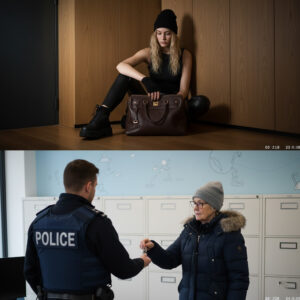In 1966 a child disappeared, 50 years later his backpack was found on the wall of the Library.
The day the schoolboy disappeared was a quiet autumn day in 1966. He left school after school around noon and was on his way home, which was just a few blocks away. His name was Justin. He was a quiet, orderly boy who didn’t usually stay in the yards and always tried to get home on time.
His mother worked in a small shop near the school and his father worked in a factory in another city, so Justin was used to being independent. Nothing portended any danger. He simply left with the books in his backpack and no one saw him again. The alarm spread in the city. When his mother realized that her son had not returned in the evening, she called the police.
The neighbors began to ask each other, but no one had seen Justin on the way home. The police sent warnings, began searching nearby vacant land, questioning casual witnesses, and looking for any clues. Some remembered seeing the boy in the school stadium. Others said they had seen a similar child at a food stall.
However, nothing could be found out for sure. At that time there were no video surveillance cameras on the streets or mobile phones. Search teams combed the surroundings, but it was all to no avail. Several days passed and the alarm intensified. The newspapers published brief notes.

A schoolboy has been lost. Please provide any information about his whereabouts. The police were searching the backyards. and they looked in the abandoned houses. At the neighborhood school where Justin studied, the teachers said he wasn’t one to run away. The principal spoke personally with the students in the hope that someone had seen something or knew what might have happened, but the children were only frightened and shook their heads.
A month of searches went by without success. The child’s parents were in a very delicate state due to uncertainty. The police, without clues, began to lean towards the version of kidnapping or some kind of accident. Volunteers, veterans and municipal organizations were mobilized. They put up posters with the photo of Justin, blond, a little taller than average for his 11 years, wearing a clean uniform and a simple leather backpack.
Distinctive features were indicated on the posters. The child had a birthmark on his right cheek. People walked the ditches of the road with dogs, searched the dumps, approached the river in the hope of finding some clue, but it was all in vain. His mother, consumed by grief, stopped going to work.
His father took a leave of absence, but no one could get close to solving the mystery. It seemed that the child had vanished into thin air. The city was gradually returning to normal, although many continued to remember the missing child in silence. Six months later, the police acknowledged that the investigation had reached an impasse.
The parents did not want to give up, but they had almost no strength or means left. Time passed, the years followed. Only a few newspaper clippings and aged photos remained in memory of Justin. They also did not find the leather backpack, neither in pawnshops nor in second-hand stores.
Some said that they had heard legends, that they had seen a similar child in another state, but every time they checked it turned out to be a mistake. No convincing evidence of Justin’s existence surfaced after the day of his disappearance. Decades passed, and the townspeople had long since stopped talking about that ancient tragedy.
The boy’s parents had aged, his health had deteriorated, and society had fully taken over a new era. The school where Justin studied had also changed. First they renovated it thoroughly at the end of the 70s and renovated the façade. Then, in the 90s, a sports complex was built.
The library remained almost unchanged, preserving the history of the building. It was a spacious room with tall solid wood bookshelves. There were lacquered reading tables and large windows that let in a lot of light. Only superficial repairs were made from time to time, painting the walls, reinforcing the shelves. But the library was not touched to save budget.
Half a century after the boy’s disappearance, it was decided to reform the school library. Modern requirements required ancillary premises and a separate area for digital technology. Contractors began tearing down the old walls, removing the siding and reinforcing the load-bearing structures. During these works, the builders stumbled upon a strange niche.
Behind a layer of plaster and a wooden panel they discovered a hole, as if it had been covered on purpose. No one understood why they had left an empty space there. When the workers broke the brick, they saw inside a dusty object that looked like an old backpack. As he approached, one of the workers whistled.
The backpack looked old with old stains. In some places the skin was worn, but in others you could read the initials. When it was brought to light, it was discovered that there was a name, Justin, and a surname that after so many years people did not immediately remember. One of the school’s veterans commented that in the distant past, a missing boy by that name had studied there.
There was a great stir. The news spread instantly. The backpack of a schoolboy who disappeared in 1966 had been found on the wall of the library five decades later. It seemed incredible. They called the police and asked them to record the finding as material evidence. The journalists did not take long to arrive.
Local newspapers and TV reporters began asking the school administration trying to figure out who might have hidden the backpack. Police cordoned off the area and conducted a preliminary examination. They unpacked the backpack carefully trying not to damage it, since after so many years the leather could fall apart in the hands.
Inside there were books on various subjects, old notebooks and a modest lunch box already empty. with only container remains. But the most disturbing thing was that in one of the pockets they found a folded sheet of paper with a brief note. The handwriting seemed rushed, irregular, as if the person had written in a hurry.
The text read, “He won’t let me go if I don’t keep silent.” The police immediately sent all found objects for analysis. It was necessary to determine whether the note and the backpack really belonged to the missing child, whether there were fingerprints or other traces of the possible criminal. The news of the discovery shocked the city.
People wondered if this was not an accidental confirmation of the old and terrible rumors. Justin’s parents had already passed away without knowing the truth. Several elderly people remembered his disappearance and said that this mystery had tormented them all their lives. No one imagined that the backpack could be on the wall of the school library.
The question arose as to how the boy’s things had gotten there and why the note sounded so scary. The investigators returned to the archives. The file on the boy’s disappearance contained little concrete data, but now they had a new reason to search the school building, especially the library.
First, the group of experts set out to search for hidden rooms or secret passageways. The plan of the building was preserved in the municipal archive, but according to the documents, the wall where they found the backpack must have been solid, without gaps. This meant that someone had deliberately created a niche and hidden the objects there.
What scared everyone the most was the note. If Justin himself had written it, it meant that he might be locked up in school and that he was forced to keep silent. And even more terrifying. Perhaps someone from the staff or among those who had access to the building had kidnapped the child. But when and how? Police reviewed the school’s employee lists from 1966.
The director, the teachers, the librarian, the technical staff. The director had died many years ago and the rest of those questioned had no special relationship with Justin. The library in those years was more modest, it had fewer shelves. It turned out that a person on duty who worked as a night watchman had left the school at the end of that same year without giving clear explanations.
Attempts to locate him at his old addresses yielded no results. Either he had moved a long time ago or he had passed away. The files turned out to be scarce, but for the moment it was the only more or less valid clue, since the guard stayed at the school after class and could have easily hidden the boy there.
Meanwhile, police expanded the registration area at the library. They knocked down another part of the wall and discovered a strange space that looked like a corridor or a small storage room that did not appear in the plans. Perhaps they had also covered it. Inside it was full of garbage, old boards, pieces of bricks, pieces of plaster.
Experts searched it all thoroughly in hopes of finding bones or other traces, but they found nothing resembling human remains. Just a few empty bottles and a metal box with a broken lock. There was nothing in the box except rust and rodent footprints. It was suspected that the perpetrator of the crime could have used that hole as a hiding place, but then, why was there only a backpack and not the child? Among the residents, restlessness and curiosity began to grow rapidly. On social networks,
people elaborated theories and accused the municipal authorities of inaction half a century ago. Those who studied at the school at the time remembered that the library was a strange place where footsteps and creaks could sometimes be heard. But all these could be simple childhood fears. Some said that after Justin’s disappearance they felt an oppressive spirit on the walls of the library.
However, all this seemed more like rumors and emotional memories. The police focused on the facts and continued to search for concrete evidence. Soon, an expert reported that the note inside the backpack contained fragmentary fingerprints that partially matched those in Justin’s old file.
Their fingerprints were taken during the search, although it is not put at 100,200. was able to confirm 100% due to the poor condition in which they were. The paper matched the period in question, and the handwriting compared to the boy’s school notebooks most likely belonged to Justin. Therefore, he had written the note himself.
The text will not let me go if I do not remain silent. It made everyone shudder. Evidently he was referring to the person who forcibly restrained the child. But why was Justin with the backpack only partially embedded in the wall and the body was never found? Police launched a new investigation into theevery stone in the schoolyard and asking the oldest neighbors.
It turned out that in 1966 there was a strange case. Someone complained about the smell in a corner of the playground behind the library. But then they blamed it on wild animals. No one thought about the connection with the boy they were looking for mainly in the vicinity, without imagining that he might be hiding in the school.
After this complaint, no one carried out an in-depth investigation. Only one policeman came, but according to witnesses, he just walked around outside and found nothing suspicious. Only now, 50 years later, has the police remembered this episode. A new team of experts excavated the floor of the schoolyard, where a foul smell was then perceived.
They expanded the area to several meters. At a shallow depth they found fragments of bones, pieces of cloth and a rusty iron plate. The forensic examination confirmed that these were human remains, specifically a small skeleton corresponding to the height of a child who had died approximately half a century ago. The clothes had decomposed, but from the buttons and shreds of cloth that were preserved, it was deduced that it could be a school uniform from the same period.
Analysis of the bone structure indicated that he was about 11 or 12 years old. The terrible hypothesis that Justina had been murdered and buried on the school grounds was confirmed. The discovery horrified all who remembered the story. The boy’s parents had already died, so there was no one to inform that the child had finally been found, even if it was in the most tragic circumstances.
The police continued with the excavation. Nearby they found a piece of rope and scraps of wood, apparently from a box or a small door. It gave the impression that the killer had held the boy in a secret room in the library and when he believed his identity was about to be discovered, he took him out into the courtyard at night, strangled him or killed him in another way and buried him.
The backpack was sandwiched in the wall. Perhaps in his haste, the killer did not want to take it away so as not to have to carry it in the street. The police reopened the investigation into the people who had access to the building. The director at the time had died as had many employees. But some veterans recalled that a man who worked as an assistant at the library behaved strangely.
He was not a watchman, but rather someone who helped with book catalogues and sometimes spent the night on the premises if new batches needed to be sorted. He had an unstable character and sometimes disappeared for weeks without warning. At the end of that same year he disappeared leaving a letter of resignation without explanation.
Rumors later surfaced that he had mental problems, but none of this was documented. The investigation tried to find evidence that could confirm that this man was involved. Old addresses were searched and attempts were made to contact his relatives. It turned out that he had passed away in the early 70s in another city and the local hospital mentioned that he had serious psychological disorders and a criminal record in his youth.
Everything indicated that if he was the murderer he would no longer be punished. Death had taken him before the truth came out. However, the police tried to reconstruct the chronology. Apparently he could have lured the boy to the library after class under the pretext of helping him or looking for a forgotten book.
He then locked him in a secret room that no one had access to. Experts suggested that in that part of the library there was a small service corridor that was later covered with wood and bricks. The murderer packed the backpack there and it is possible that the boy managed to hide the note inside in the hope that one day they would find it.
But it’s unknown how long Justin was locked up. The note said that he had to keep quiet because otherwise he would not let him go. Most likely, the little prisoner feared punishment or had no chance of escaping. The mentally ill man kept him there until he realized that the whole city was searching for the missing boy and that the danger of being discovered was great.
He then decided to kill the boy when the press learned that bones corresponding to the boy’s remains had been found behind the schoolyard. 50 years after his disappearance, society was shaken. Reporters wrote heartbreaking articles about the abandoned boy who was searched for across the district while standing nearby behind the walls of his school.
The story awakened old fears and feelings of helplessness. The school’s principal publicly apologized to the remaining family members. Although Justin had almost no direct descendants or close relatives, the inhabitants of the city saw that the educational institution had no intention of silencing the facts. The school staff placed a small memorial plaque on the wall for everyone to remember the tragedy of the negligence of those times.
The police concluded a new investigation and indicated in their report that the alleged perpetrator was a library employee who suffered from a mental disorder. There is no direct evidence, except for coincidences between indirect indications and the location, but no other suspects have been identified. Psychiatric clinics confirmed that this man surnamed Wilton, we will call him that for convenience, had attacks of aggression and was under observation.
He changed his address shortly after the child’s disappearance. One of the witnesses claimed to have seen him prowling around the schoolyard at night, but without official statements in the file, this information remained in the realm of rumors. Now, after so many years, the case has come to an end.
The people who worked as laborers and found the backpack said that at night they dreamed of the boy’s face and the short sentence he had written on a piece of paper. During all that time, The boy was hoping to be rescued, but he disappeared without a trace and no one solved the mystery immediately.
One newspaper published an article titled 50 Years of Silence. The truth was walled up. Public opinion continued to hotly debate the issue on social media and in meetings for some time, but gradually life returned to normal and the story lost its novelty. The school administration, to honor his memory, decided to dedicate a special panel to him in the library with photos of the time and a short text explaining who Justin was and how that ancient tragedy ended. Everything was done without much pomp.
since they did not want to turn the school into a tourist place for horror lovers. Instead, they set out to teach the children and teachers a lesson. You have to be more attentive to each other and not ignore strange details that can save someone’s life. Several parents of pupils said they were scared, as their son had disappeared under such horrific circumstances right at school.
The director assured everyone that under the current conditions such a thing is impossible, as the building was rebuilt a long time ago and the security systems have been improved. Justin’s skeleton or what was left of him was turned over to forensics and then officially buried. A handful of neighbors organized a brief ceremony to pay tribute to the boy they described in life as smiling, kind and intelligent.
The funeral was attended by a distant elderly relative. she remembered that Justin wanted to be a teacher and helped younger children with homework. Of course, their parents didn’t live to see it, but people said that at least now the truth was known and that perhaps their souls had found peace.
In the final report, police wrote that no direct charges could be brought against the deceased librarian or any other school employees, as there were no suspects alive. The case was closed again, but this time with the conclusion that the boy’s death had been violent related to the illegal detention and murder.
Evidence indicated that the child had died shortly after his disappearance. The note indicates the fear of the aggressor who demanded silence. He allegedly threatened to kill Justin or his loved ones if he tried to call for help. Perhaps the boy thought he could write that phrase and hide it in his backpack so that someone would find it one day, but he could hardly imagine that half a century would pass.
Researchers and journalists wondered, how is it possible that no one heard screams or footsteps inside the library? Perhaps the criminal chose a time when no one was at school and the child was too scared to call for help. In those years there was not much traffic of students in the afternoon, nor security guards, nor cameras.
The building was locked and several employees could stay there freely in the dark. This case became one of those that show how easy it was in the past to commit crimes without leaving almost any trace. The workers who finished the renovation of the library carefully restored the wall, leaving a special ventilation and checking all the gaps so that there were no more secret niches.
The director asked them to be careful and treat the old boards carefully so as not to lose any evidence, but no new findings were made. Apparently, the murderer only cared about hiding the footprints and hid the backpack, probably in a hurry. Perhaps he was thinking of taking it out later, without anyone noticing and destroying it, but he did not have time or was scared.
In the end everything was cooked inside the wall. When the wave of interest in the event passed, some people began to go to the library and ask where the backpack had been found. The school management tries not to encourage this curiosity, because the building is an educational center, not a place of excursion. In the teachers’ room, they sometimes tell each other how they felt a chill when walking down the corridor, although they know that it is only their management.
One way or another, life goes on. But no one will forget this example of how easy it was in the past for terrible events to happen, literally at the doors of the classroom. One of the young police officers who participated in the new investigation said in an interview that this case had had a great impact on him.
I didn’t think that such old cases could be solved suddenly. That is why he began to pay more attention to reports of missing children, even if at first glance they seemed insignificant or were simply children who had run away from home. Now he only has that backpack and the creepy phrase written on a piece of paper in his memory.
When he told his wife what he had seen, she asked him not to talk about it in front of the children again. They didn’t want their children to grow up in fear. But the policeman considered it important to warn that sometimes danger lurks where it is least expected. For several months, the city discussed different versions.
And if several people had participated in the crime, not just one, the police had no evidence of complicity. Some said the school principal might know, but feared the shame. Others recalled the fights the boy had allegedly had with adults, but none of these rumors were confirmed by facts.
The official version boiled down to a mentally ill person luring and detaining the boy, then killing him and burying him in the courtyard, trying to hide the evidence. With this, the investigation was closed. Shortly after, the library was renovated, a new floor was installed, modern furniture and computers were installed, and ventilation was improved.
Posters urging people to read and photos of recent graduates were hung on the walls. The place where the backpack was found is now covered with books and inconspicuous. Students born in the new century see nothing mystical about the library. Only a few of them have heard their parents talk about the terrible story, and they whisper fearfully in a corner.
But there is no cause for concern. The school continues with its normal life, where the important thing is studying and growing. The local authorities decided that a small memorial corner could be created in the schoolyard, with flowers or a plaque placed in honor of all the missing children.
But the initiative quickly faded because no sponsors were found, and most parents wanted the school atmosphere to remain positive. Justin’s remains were buried in the local cemetery next to his parents’ graves, with the inscription, “The one they couldn’t save, but they didn’t forget.”
Only a few people who truly remembered those events attended the ceremony. They remained silent for a few minutes, aware that the events of half a century ago could be recalled again. Thus ended this story. A boy disappeared on his way home in 1966. The search lasted months without results, and 50 years later, his backpack was suddenly found on the wall of the old school library.
A short note was also found there. “He won’t let me go if I don’t keep silent.” The investigation revealed that a mentally ill person with access to the building had held the boy in a secret room, then murdered and buried him in the schoolyard. The identity of the killer could not be definitively confirmed, as the suspect had been deceased for some time.
The city was shaken, but eventually everyone returned to their daily activities. The tragedy was in the past, but now it has come to an end. People came to the conclusion that no horror can be justified by silence and that sometimes secrets hidden behind walls eventually come to light, even after half a century.
News
I composed a message: “I’m so scared to be alone tonight” but sent it to my husband by mistake. Unexpectedly, because of this, I discovered his shocking secret.
I composed a message: “I’m so scared to be alone tonight” but sent it to my husband by mistake. Unexpectedly, because of this, I discovered his shocking secret. I met Ryan Carter in college — the best years of my life, in…
A Thug Strangled Ronda Rousey’s Daughter, But Never Expected the UFC Champion to Show Up
A Thug Strangled Ronda Rousey’s Daughter, But Never Expected the UFC Champion to Show Up (00:00) thought no one would stop him. A bully strangled Ronda Rousy’s daughter in front of the entire school, while everyone stood watching and filming….
My husband moved in with his lover, I quietly drove my paralyzed mother-in-law to return him. Before leaving, I said something that made both of us tremble with anger.
My husband moved in with his lover, I quietly drove my paralyzed mother-in-law to return him. Before leaving, I said something that made both of us tremble with anger. I married Michael seven years ago.It wasn’t a perfect marriage, but I always…
The Little Girl Kn0ck3d And Said, “They B3@t My Mom, She’s Dying” The Giant Rancher Left Them All…
The Little Girl Kn0ck3d And Said, “They B3@tMy Mom, She’s Dying” The Giant Rancher Left Them All… On the dusty Sonoran desert sunset, the wind whipped like a wounded coyote, dragging skin-stinging sand like needles. The El ranch stood imposing,…
After her mother-in-law left, Mary accidentally found a packet of white powder in her purse. Ten minutes later, her mother-in-law returned with the police, but a very unpleasant surprise awaited her………
After her mother-in-law left, Mary accidentally found a packet of white powder in her purse. Ten minutes later, her mother-in-law returned with the police, but a very unpleasant surprise awaited her……… This day was unusual for the young woman. She…
A beautiful girl from a poor family went to the city to work as a maid in a luxury villa. On payday, her boss suddenly pulled her into the bedroom and whispered a shocking story to her.
A beautiful girl from a poor family went to the city to work as a maid in a luxury villa. On payday, her boss suddenly pulled her into the bedroom and whispered a shocking story to her. Lena Martinez grew up…
End of content
No more pages to load











